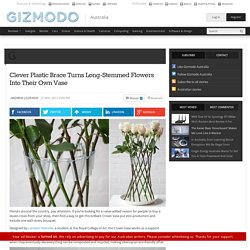

Can Le Edge a £5 scraper give you perfect skin? Australian invention 'Le Edge' can be used to exfoliate the entire bodyIt's inspired by an Ancient Roman curved metal bathing tool used to scrape oil, dirt and dead skin cells of the surface of skinMetal edges scrape away dead cells and soap residue for a glowing complexionOnly hot water is needed to use it, and it costs as little as £5Clare Goldwin tries it out and gives her verdict By Clare Goldwin Published: 21:45 GMT, 20 July 2014 | Updated: 09:07 GMT, 21 July 2014 Until now, exfoliating has required taking countless products into the shower.

From foot to body to face, each part needs a different formulation of scrub depending on how rough or delicate the skin. Exfoliating is important to remove dead cells from the skin’s surface, as they can leave skin looking dull and dry. Smooth operator: Clare tries out Le Edge Le Edge looks like a small car de-icing tool. CandyShell Amped case doubles phone's speaker volume WITHOUT cables or batteries. CandyShell Amped case claims to double volume on an iPhone 5 and 5SIt doesn’t use cables, batteries, Bluetooth or external speakersInstead, the case’s interior is carved with a horn-shaped waveguide This redirects sound from the speakers on the bottom up to a side grill By Victoria Woollaston Published: 15:32 GMT, 11 July 2014 | Updated: 20:07 GMT, 11 July 2014 No matter how hard the likes of Apple, HTC and Samsung try to boost the quality of their handsets’ sound, they are still lacking.

The CandyShell Amped case offers a solution by promising to double the volume on the iPhone 5 and 5S without the use of cables, batteries or speakers. Instead, the case’s interior is carved with a horn-shaped waveguide that directs sound from the speakers on bottom up to a grill on the side. Cardboard. Crucible Industrial Design. When our local pub starting selling 'Boar's Head Bitter', they made their own beer pump badge from paper.

We saw an opportunity to do something really useful with 3D printing and possibly earn a few free pints... First, we developed a fairly traditionally themed badge design, using a combination of digitally printed polystyrene board for the graphics and 3D printed parts for the frame and central logo. We then got the graphic part printed at Hobs Repro at Milton Park, and asked Plunkett Associates to make the frame and logo using Selective Laser Sintering (SLS).
Finally, we rubbed down the SLS parts and gradually achieved the desired finish with layers of primer and gold paint before bonding all the parts together. The new badge was delivered on the first anniversary of the new tenants of the the Boar's Head.
Forget breadmakers - now you can buy a BEERMAKER: Tabletop brewery lets anyone make a pint of homebrew in their kitchen. The machine allows users to add a handful of fresh ingredients into it and push a button to make a keg of beer.PicoBrew Zymatic costs $1,600 (£992) and claims to brew 'high quality all-grain beer' in a week from three ingredientsThe invention, which has exceeded its fundraising target on crowd-funding website Kicktstarter, is the brainchild of two brothers in Seattle By Sarah Griffiths Published: 10:41 GMT, 22 October 2013 | Updated: 14:57 GMT, 22 October 2013 Plenty of people have installed breadmakers in their kitchens to make fresh loaves, but now a company in Seattle plans on launching a compact home-brewing system so beer fans never run out of pints.

Just like a breadmaker, the microwave-sized machine allows users to add a handful of fresh ingredients into it and push a button to make a keg of beer. Australian scientists created light-weight 3D printed titanium horse shoes. Oct.16, 2013 Australian scientists have created a customized set of purple titanium shoes for a Melbourne race horse using 3D printing.

To create the titanium shoes, scientists from the Commonwealth Scientific and Industrial Research Organisation (CSIRO) first scanned each hoof of the horse, nicknamed 'Titanium Prints', using a 3D scanner to generate a computer aided design (CAD) file. The CAD files are then sent to the 3D printing machine. Australian scientists created light-weight 3D printed titanium horse shoes. Olaf Diegel's spectacular Steampunk 3D printed guitar.
Oct.3, 2013 The Steampunk 3D printed guitar is the latest creation from Olaf Diegel, a long-standing design engineer, with a passion for 3D printing.

Olaf is professor of mechatronics and Massey University in Auckland, New Zealand, and he has created a range of personalisable, customisable guitars with 3D printed bodies. How your heartbeat could replace passwords. Clever Plastic Brace Turns Long-Stemmed Flowers Into Their Own Vase. Florists around the country, pay attention.

If you’re looking for a value-added reason for people to buy a dozen roses from your shop, then find a way to get this brilliant Crown Vase put into production and include one with every bouquet. Designed by Lambert Rainville, a student at the Royal College of Art, the Crown Vase works as a support allowing flowers to stand via their own stems, like a simple shelter crafted by an experienced outdoors person.
Bikes. A blog about art and visual ingenuity. Complex Cardboard Columns Through Computational Architecture. Michael Hansmeyer is an architect and programmer currently based in Zurich who explores the use of algorithms and computation to generate architectural structures.

He has created an algorithm that explores how subdivision can define and embellish the column order with an elaborate system of ornamentation. He has produced a full-scale, 2.7-meter high variant of the columns by use of layering with 1mm cardboard sheets, where each sheet is individually cut using a mill or laser. Sheets are then stacked and held together by poles that run through a common core.
All I have to say is WOW! “The calculation of the cutting path for each sheet takes place in several steps. Via Michael Hansmeyer. Incredible Amsterdam Office Created Entirely From Cardboard Nothing Cardboard Office by Joost Van Bleiswijk. Van Bleiswijk’s design work draws inspiration from historic industrial design objects that have been forgotten, like the writing desk, the standing clock, the hourglass, and even the chessboard.

The designers created an entire office space by carefully cutting and folding sheets of 15 mm honeycomb cardboard. The area includes desks, tables, bookshelves, columns, stairs, and even rooms made out of the material. Cardboard PC takes quixotic stand against PC cases. This concept for, essentially, a cardboard box you put your PC components in, is designed to be a replacement for the tower cases that end up sitting in landfills when you upgrade.

I appreciate the idea, but I’m afraid they’re tilting at windmills here. Like Asus’ bamboo laptop, this is a mere shell of eco-friendliness. Designer Ron Arad discusses his 3D-printed sunglasses. April 27, 2013 Using 3D printing as tool London designer Ron Arad has created a serie of 3D-printed sunglasses for eyewear brand pq. "pq is a new brand that we started from the ground up," Arad says. It is called pq because when you write p and q it is like you are drawing glasses, explains Arad. 225752_250518795086682_2116673872_n.jpg (582×960) Programmable logic controller. Siemens Simatic S7-400 system at rack, left-to-right: power supply unit PS407 4A,CPU 416-3, interface module IM 460-0 and communication processor CP 443-1.
History[edit] Digital computers, being general-purpose programmable devices, were soon applied to control of industrial processes.
Let’s Collaborate on Open Source Hardware Design. I met with Marcin Jakubowski, founder of Open Source Ecology, and Catarina Mota, founder of Open Materials and co-chair of the Open Hardware Summit, in Lisbon a few months ago. We visited Altlab, the oldest Hackerspace in Lisbon, and spent a couple of days together talking about how we could create new foundations for more collaboration on Open Hardware design and documentation. In fact, our eventual objective--an open source hardware ecosystem based on shared practices--is still not here, and many hardware developers in the world are now experimenting with different ways to create and share their projects. Photography From The Future: Will We Be Printing Our Own Cameras? 3D printing is making huge leaps in the last few years. The idea of 3D printing has changed and evolved from being a (relatively) rapid prototyping tool to being a small home fabrication unit.
Operating a 3D printed is easier now than ever, materials are cheaper and even the printers themselves are now around the $1,500 mark (Up, Makergear and the good ol’ Replicator are two good examples). This got me thinking, will we be printing our own camera and camera accessories in the near future? This question is already partly answered. The amount of 3D printed accessories DIYP gets is staggering.
GARDEN TOWER: Composting + 50 Plants = Fresh Food Anywhere. by Garden Tower Project. The Garden Tower grows a surprising number of vegetable and flower varieties. Windowfarms - Vertical Garden for Growing Herbs and Vegetables at Home. DIY Pop-Up Workshop Fits on Your Bike. Farewell to fat-fingered errors on your smartphone thanks to extra tips that you can even wear with gloves. Israeli entrepreneur creates cardboard bicycle for just $9.
While researchers and auto designers are thinking about replacing steel with carbon fiber to make bicycles light in weight and more efficient, not to mention more expensive as well, Izhar Gafni, an Israeli entrepreneur has come up with an affordable solution in the form of a bicycle made using corrugated cardboard. Farm Hack. Nomiku - Let's Cook Better. 3D printing: Making the engineer like a new kind of potter… / L’impression 3D: Faire de l’ingénieur un nouveau type de potier … While working, the carver or the machinist frees the object already contained in the raw material.
The emerging sculpture or piece is rid of surplus material by each stroke of the tool. That’s the way hard objects have always been carved. Nomadic Furniture: D-I-Y Projects That Are Lightweight & Light on the ... - James Hennessey, Victor J. Papanek. How to Make Everything Ourselves: Open Modular Hardware. A modular system unites the advantages of standardisation (as parts can be produced cheaply in large amounts) with the advantages of customisation (since a large diversity of unique objects can be made with relatively few parts).
Modularity can be found to a greater or lesser extent in many products (like bicycles and computers) and systems (like trains and logistics), but the best examples of modular systems are toys: LEGO, Meccano, and Erector (which is now the brand name of Meccano in the US). LEGO, Meccano and Erector are composed of relatively few elementary building blocks, which can be used to build various objects. Students Build Bike-Powered Charging Station from Scratch. CYCLEAN BIKE-POWERED WASHING MACHINE. Turns out riding a bike can have more benefits than simply exercise or green-transportation… these days your pedal power can provide juice for your cell phone, the TV at your gym, and now even your washing machine. Home. Www.cd3wd.com - alexweir1949 - cd3wd - High Quality Technical Development Info for the Third World - and the SEEV fraud-proof voting system for the Third World - last updated 2011/03.
Www.tinytechindia.com/Template/index.php. FPO IP Research & Communities. About Willow Garage. What We Do Willow Garage develops hardware and open source software for personal robotics applications. Vision We see personal robots as the next paradigm-shifting personal productivity tool. By investing in open source and open platform adoption models, we aim to lay the groundwork for the use of personal robotics applications in everyday life. A Safer Stove For The Developing World, Created By Indian Student Entrepreneurs. In developing nations around the world, almost three billion people endanger their health by using mud stoves and indoor open fires. ONAWI - Open Renewables. Marcin Jakubowski: Open-Sourced Blueprints For Civilization. Heathkit Virtual Museum. Kits and Revolutions.